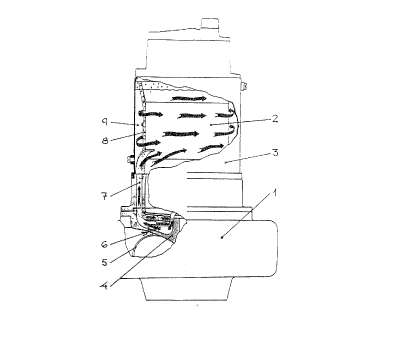Some of the information on this Web page has been provided by external sources. The Government of Canada is not responsible for the accuracy, reliability or currency of the information supplied by external sources. Users wishing to rely upon this information should consult directly with the source of the information. Content provided by external sources is not subject to official languages, privacy and accessibility requirements.
Any discrepancies in the text and image of the Claims and Abstract are due to differing posting times. Text of the Claims and Abstract are posted:
| (12) Patent: | (11) CA 2077303 |
|---|---|
| (54) English Title: | MOTOR AND COOLING MEANS THEREFOR |
| (54) French Title: | MOTEUR ET MODE DE REFROIDISSEMENT DE CELUI-CI |
| Status: | Deemed expired |
| (51) International Patent Classification (IPC): |
|
|---|---|
| (72) Inventors : |
|
| (73) Owners : |
|
| (71) Applicants : | |
| (74) Agent: | SMART & BIGGAR |
| (74) Associate agent: | |
| (45) Issued: | 1997-08-19 |
| (22) Filed Date: | 1992-09-01 |
| (41) Open to Public Inspection: | 1993-03-04 |
| Examination requested: | 1992-09-01 |
| Availability of licence: | N/A |
| (25) Language of filing: | English |
| Patent Cooperation Treaty (PCT): | No |
|---|
| (30) Application Priority Data: | ||||||
|---|---|---|---|---|---|---|
|
The stator housing of an electric motor
has its central, rotary axis offset from,
and parallel with, the longitudinal axis
of its enclosing casing. The housing and
casing define a cooling liquid chamber
therebetween which, due to the offset
axes, define the chamber of diverse
widths. A wall, of arcuate conformation,
is joined to the casing to render the
chamber of uniform width thereabout and
therealong, and to form a separate,
lateral compartment in which to confine
conduits for conducting cooling liquid
into the chamber.
e logement du stator d'un moteur électrique a son axe de rotation central décalé et parallèle par rapport à l'axe longitudinal de son carter. Le logement et le carter délimitent entre eux une chambre de liquide de refroidissement, ce qui, en raison des axes décalés, donne à la chambre diverses largeurs. Une paroi arquée est ajoutée au carter afin de donner à la chambre une largeur uniforme et constituer un compartiment latéral séparé dans lequel sont confinés des conduits pour acheminer le liquide de refroidissement à la chambre.
Note: Claims are shown in the official language in which they were submitted.
Note: Descriptions are shown in the official language in which they were submitted.

For a clearer understanding of the status of the application/patent presented on this page, the site Disclaimer , as well as the definitions for Patent , Administrative Status , Maintenance Fee and Payment History should be consulted.
| Title | Date |
|---|---|
| Forecasted Issue Date | 1997-08-19 |
| (22) Filed | 1992-09-01 |
| Examination Requested | 1992-09-01 |
| (41) Open to Public Inspection | 1993-03-04 |
| (45) Issued | 1997-08-19 |
| Deemed Expired | 2011-09-01 |
There is no abandonment history.
| Fee Type | Anniversary Year | Due Date | Amount Paid | Paid Date |
|---|---|---|---|---|
| Application Fee | $0.00 | 1992-09-01 | ||
| Registration of a document - section 124 | $0.00 | 1993-03-26 | ||
| Maintenance Fee - Application - New Act | 2 | 1994-09-01 | $100.00 | 1994-08-15 |
| Maintenance Fee - Application - New Act | 3 | 1995-09-01 | $100.00 | 1995-08-16 |
| Maintenance Fee - Application - New Act | 4 | 1996-09-02 | $100.00 | 1996-08-16 |
| Final Fee | $300.00 | 1997-04-11 | ||
| Maintenance Fee - Patent - New Act | 5 | 1997-09-02 | $150.00 | 1997-08-15 |
| Maintenance Fee - Patent - New Act | 6 | 1998-09-01 | $150.00 | 1998-08-18 |
| Maintenance Fee - Patent - New Act | 7 | 1999-09-01 | $150.00 | 1999-08-16 |
| Maintenance Fee - Patent - New Act | 8 | 2000-09-01 | $150.00 | 2000-08-16 |
| Maintenance Fee - Patent - New Act | 9 | 2001-09-04 | $150.00 | 2001-08-16 |
| Maintenance Fee - Patent - New Act | 10 | 2002-09-03 | $200.00 | 2002-09-03 |
| Maintenance Fee - Patent - New Act | 11 | 2003-09-01 | $200.00 | 2003-04-22 |
| Maintenance Fee - Patent - New Act | 12 | 2004-09-01 | $250.00 | 2004-08-12 |
| Maintenance Fee - Patent - New Act | 13 | 2005-09-01 | $250.00 | 2005-08-09 |
| Maintenance Fee - Patent - New Act | 14 | 2006-09-01 | $250.00 | 2006-08-21 |
| Maintenance Fee - Patent - New Act | 15 | 2007-09-04 | $450.00 | 2007-07-30 |
| Maintenance Fee - Patent - New Act | 16 | 2008-09-02 | $450.00 | 2008-08-13 |
| Maintenance Fee - Patent - New Act | 17 | 2009-09-01 | $650.00 | 2010-03-18 |
Note: Records showing the ownership history in alphabetical order.
| Current Owners on Record |
|---|
| ITT FLYGT AB |
| Past Owners on Record |
|---|
| BRANDT, BENGT |